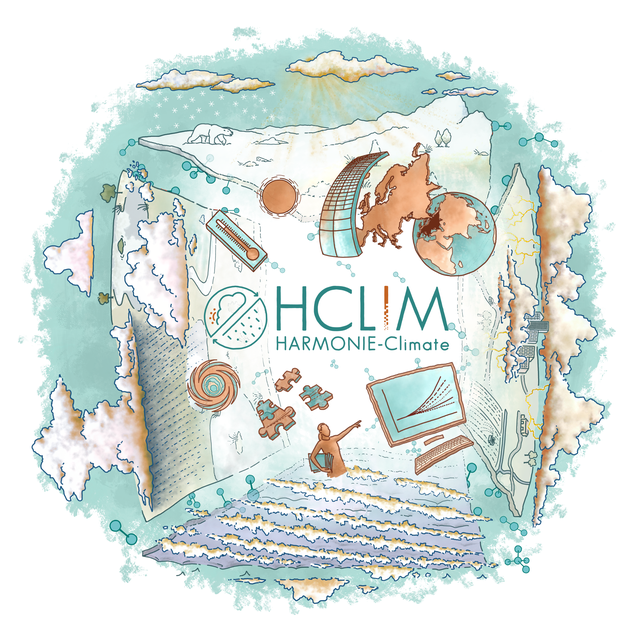HCLIM
HCLIM is a seamless model framework developed jointly between several European national meteorological services. The model system provides flexibility as it contains a suite of different atmospheric model configurations, each adapted for different horizontal resolutions.

The framework, which facilitates observation handling, climate generation, lateral boundary coupling, and postprocessing is referred to as HCLIM, the climate version of the HIRLAM–ALADIN Research on Mesoscale Operational NWP in Euromed (HARMONIE) system.
Model description
HCLIM is developed by a consortium of national meteorological institutes in close collaboration with the HIRLAM-ALADIN NWP and ACCORD model development. HCLIM includes three different atmospheric physics packages AROME, ALARO and ALADIN, which are designed for use at different horizontal resolutions. The latest version is HCLIM43, succeeding the prior versions, HCLIM38 and HCLIM36. Proven effective in various simulations across different domains and international collaborative projects, HCLIM stands out as a robust regional climate modelling system.
HCLIM-AROME is specifically developed for use at convection permitting resolutions, resolving deep convection explicitly and is generally applied to horizontal resolutions finer than four kilometers. In HCLIM-AROME, the nonhydrostatic dynamical core, developed by ALADIN is used. It solves the fully compressible Euler equations using a two time level, semi-implicit, semi-Lagrangian discretization on an Arakawa A grid. In the vertical, a mass-based hybrid pressure terrain-following coordinate is used.
HCLIM-AROME parameterized radiation using a two-stream approximation in model columns and the effects of surface slopes are accounted for.

HCLIM illustration. By: Jagoba Malumbres-Olarte.
HARMONIE-AROME uses a mixed-phase microphysics scheme, the ICE3 scheme with additional modifications for cold conditions called OCND2, wherein cloud water and ice as well as rain, snow, and graupel are prognostic variables. Hail is assumed to behave as large graupel particles. The turbulence parameterization is the scheme called HARMONIE with RACMO Turbulence.
HCLIM-ALARO is typically used for grid sizes of four kilometers and larger, employing the hydrostatic version of the dynamical core. ALARO-0 was employed in HCLIM38. The newer version ALARO-1 has not been implemented in HCLIM to date.
Deep convection is parameterized using the 3MT scheme, which separates resolved large-scale and convective clouds to avoid double counting convective processes at higher resolutions. The turbulence parameterization is a pseudoprognostic turbulent kinetic energy (pTKE) scheme, an extension of the Louis-type vertical diffusion scheme.
HCLIM-ALADIN, used as a hydrostatic model, is employed for simulations with grid spacing close to or larger than 10 kilometers. It is the limited-area version of the global model ARPEGE, from which it inherits all dynamics and physics options. Similarly to AROME, the radiation scheme is a simplified radiation scheme adapted from ECMWF.
The surface parameterization framework in HCLIM is SURFEX. The subgrid surface heterogeneity is represented by four tiles which encompass continental natural surfaces, sea, inland water and urban areas. Urban surfaces are simulated by the Town Energy Balance scheme that is based on the Urban Canyon approach. Natural surfaces are parameterized using the Interactions Soil-Biosphere-Atmosphere model. The inland water is simulated by the lake model FLake. SURFEX is an external surface modelling system available off-line as well as coupled to atmospheric models. When coupled to an atmospheric model, SURFEX receives variables such as downward short-wave and long-wave radiation, surface air pressure, air temperature, humidity, wind and precipitation for every time step and then uses them to compute momentum and surface energy fluxes.
Selected publications
- 2022: Climate change information over Fenno-Scandinavia produced with a convection-permitting climate model (springer.com)
 External link.
External link. - 2020: HCLIM38: a flexible regional climate model applicable for different climate zones from coarse to convection-permitting scales (copernicus.org)
 External link.
External link.
